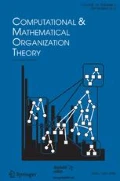Abstract
A procedure is described for finding sets of key players in a social network. A key assumption is that the optimal selection of key players depends on what they are needed for. Accordingly, two generic goals are articulated, called KPP-POS and KPP-NEG. KPP-POS is defined as the identification of key players for the purpose of optimally diffusing something through the network by using the key players as seeds. KPP-NEG is defined as the identification of key players for the purpose of disrupting or fragmenting the network by removing the key nodes. It is found that off-the-shelf centrality measures are not optimal for solving either generic problem, and therefore new measures are presented.
Similar content being viewed by others
References
Borgatti SP (2002) Stopping terrorist networks: Can social network analysis really contribute? Sunbelt International Social Networks Conference 13–17. New Orleans
Borgatti SP, Everett MG (1999) Models of core/periphery structures. Social Networks 21:375–395
Borgatti MG, Jones C, Everett MG (1998) Network measures of social capital. Connections 21(2):27–36
Burt RS (1992) Structural Holes: The social structure of competition. Harvard University Press, Cambridge
Coleman J (1990) Foundations of social theory. Belknap Press, Cambridge, MA
Everett MG, Borgatti SP (1999a) Peripheries of cohesive subsets. Social Networks 21:397–407
Everett MG, Borgatti SP (1999b). The centrality of groups and classes. Journal of Mathematical Sociology. 23(3):181–201
Freeman LC (1979) Centrality in social networks: Conceptual clarification. Social Networks 1:215–239
Friedkin NE (1991) Theoretical foundations for centrality measures. American Journal of Sociology 96:1478–504
Glover F (1986) Future paths for integer programming and links to artificial intelligence. Computers and Operations Research 5:533–549
Holland J (1975) Adaptation in natural and artificial systems. University of Michigan Press
Kernighan BW, Lin S (1970) Efficient heuristic procedure for partitioning graphs. Bell Systems Technical Journal 49(2):291–297
Krebs V (2002) Uncloaking terrorist networks. First Monday 7(4) http://www.firstmonday.dk/issues/ issue7_/krebs/index.html
Metropolis N, Rosenbluth A, Rosenbluth M, Teller A, Teller E (1953) Equation of state calculations by fast computing machines. J Chem Phys 21(6):1087–1092
Morris M, Kretzschmar M (1997) Concurrent partnerships and the spread of HIV. AIDS 11:641–648
Seidman S (1983) Network structure and minimum degree. Social Networks 5:269–287
Author information
Authors and Affiliations
Corresponding author
Additional information
Stephen P. Borgatti is Professor of Organization Studies at the Carroll School of Management, Boston College. His research is focused on social networks, social cognition and knowledge management. He is also interested in the application of social network analysis to the solution of managerial problems.
Rights and permissions
About this article
Cite this article
Borgatti, S.P. Identifying sets of key players in a social network. Comput Math Organiz Theor 12, 21–34 (2006). https://doi.org/10.1007/s10588-006-7084-x
Issue Date:
DOI: https://doi.org/10.1007/s10588-006-7084-x




